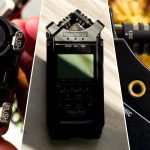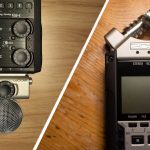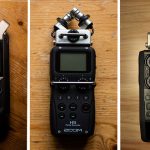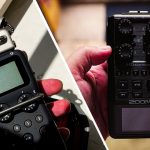So you want to buy a new digital recorder, and you’ve been enticed by the cosmetic makeover of Zoom’s product line. After careful deliberation, you’ve managed to narrow down your options to the Zoom H6 Black and the Zoom H4N Pro Black, but you can’t seem to decide between the two.
On the one hand, the Zoom H4N Pro model offers a budget friendly and extremely mobile recorder, while on the other hand, the Zoom H6 offers a greater range of use cases and adaptability.
In this article, I will provide you with a detailed comparison of both of Zoom’s recorders mentioned above, as well as which one you should purchase, based on how you intend to utilise the device.

Differences
First, I’d like to quickly cover the differences between the new black versions, and the older ones.
In the case of the Zoom H4n Pro, I couldn’t find any difference, except for the black finish. When it comes to the H6, you actually get less than what you got with the older, Grey version.
With the new one you no longer get the MS capsule, nor do you get the plastic carry case that comes with the older model. I assume Zoom did some market research, and found that most people didn’t care about those.
Affordability
Now, as mentioned at the start of the video, the Zoom H4N Pro is usually the less expensive option, whether you’re buying new, or used. The Zoom H6, however, is also a very affordable option and will only set you back slightly more than the alternative.
Now that we have briefly discussed affordability, it’s time to delve deeper into the features of the recorders in order to explain both the differences and similarities between the two devices.

Inputs
One of the key differences between these two recorders is the number of XLR/TRS inputs each device has. XLR inputs are often used in conjunction with larger microphones, such as shotgun and podcast mics, like the Shure SM7B. XLR inputs also offer the use of phantom power if your condenser microphone requires it.
In any case, the Zoom H4N Pro contains a total of two XLR/TRS inputs, while the Zoom H6 has a greater capacity for utilising external microphones through the use of its four inputs.
In fact, not only does the Zoom H6 provide you with more in-built XLR/TRS inputs, but it also offers an option to increase this number to a comprehensive six XLR/TRS inputs when used in cooperation with the EXH-6 Combo Input capsule.
As a quick side note, the H6 can not provide Phantom Power to the EXH-6, so if you’re planning on connecting six condensers to it, the Zoom H8 might be a better choice.
Of course, the influence that the number of inputs has on your decision to purchase either the H4N Pro or the H6 alternative will likely depend on how you intend to use the device in the first place. For example, if you are planning on conducting face to face interviews then the two XLR/TRS inputs on the H4N Pro should suffice.
In fact, you don’t even need to plug in two external microphones. Obviously that will produce a more professional sounding interview, but I’ve seen plenty of interviews conducted with a Zoom H4n Pro placed in-between the speakers.
Again, this will not produce professional results, as it will introduce quite a bit of noise, both due to the distance of the speakers from the mic, and as a result of ambient noise.
However, if you are planning on recording a podcast with numerous guests, or location audio for your short film, you are likely to find that the two XLR/TRS inputs are simply inadequate for your needs, and you require the four (or even six) inputs provided by the H6.
Both recorders also provide a 3.5mm input, for lavalier mics. On the H4n Pro, this can be found at the back of the device, towards the top.
In the case of the H6, this is actually built into the X/Y capsule. Bear in mind that not all of the capsules have 3.5mm inputs, as I found out when I checked my SGH-6 capsule.
Portability
When it comes to portability, Zoom recorders have always been light and handy, while retaining their rugged sturdiness, and the H4N Pro and H6 models are no exception. Both devices weigh in at approximately 280 grams, whilst the H6, with the included X/Y mic capsule weighs around 410g.
Regardless of which device you choose, they afford the user a great deal of mobility when recording on the move and when travelling.
The H4N Pro is also slightly more compact when compared to its H6 counterpart. In addition, the H4n Pro comes with a hard plastic case, which will protect it from accidental bumps and scuff marks. Unfortunately, this is not the case for the H6 All Black.
The older, grey H6 came with a hard plastic carrying case, but the new version doesn’t come with it, nor does it come with the MS capsule that the older version had. We’ll get into capsules a bit later on in the article though.
Despite this inconsistency between the two, each option feels well-built and solid in the hand, giving you the feeling that both were designed with durability in mind.
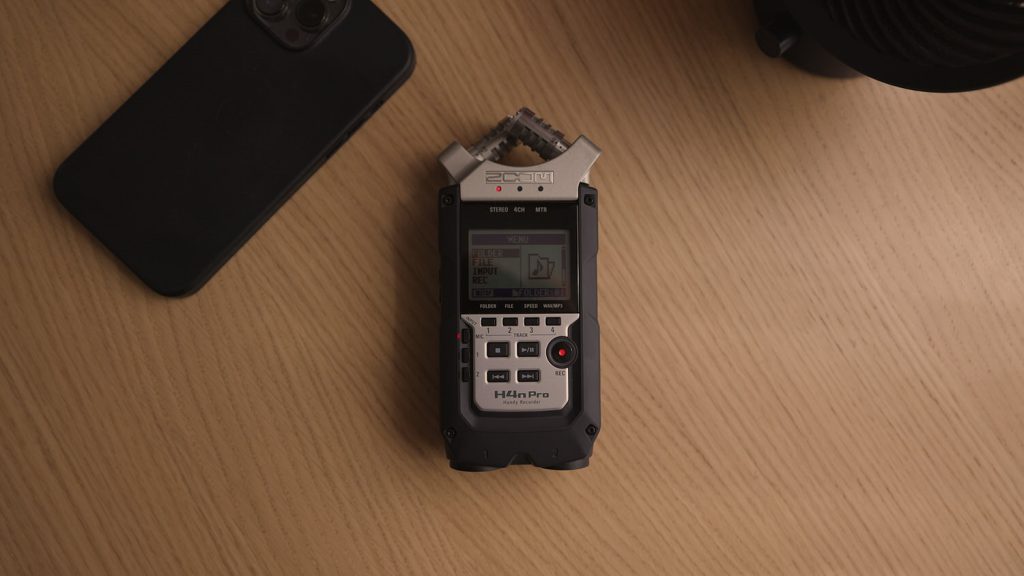
Battery
In terms of battery performance, both the H4N Pro and the H6 run on AA batteries, but in terms of battery performance the H6 has a significant advantage over the H4N Pro model, which seems to drain the batteries much quicker.
With reference to recording time, Zoom states an approximate battery life of 20 hours for the H6, which in my experience is a fair estimate.
Meanwhile, Zoom suggests that the H4N Pro provides users with six hours of battery life, however when collating the community’s experiences, as well as reflecting on my own experience while using the H4N Pro, it seems that Zoom may have made an overestimation when quoting the six hours of battery life.
So, be sure to pack plenty of spare batteries if you plan on recording for any amount of time with the device.
Alternatively, you could run either device off the mains. You can purchase accessory packs for each recorder, namely the Zoom APH-6 and the Zoom APH-4n Pro. Both will provide the means to plug the recorders in, and run them off constant power, so you don’t have to worry about battery life.
Free Sound Effects
By the way, did you know I have compiled the largest list of free sound effects in the world? Over 500GB of sounds, ready to be downloaded, free of charge. Just figured you’d want to know. And now, back to the review.
Audio Quality & Wind Resistance
One of the most important aspects to consider when purchasing a handheld recorder is the audio quality. Both the H4N Pro and the H6 can produce fantastic results, under the right circumstances.
For example, the voice over for this video, as well as a few of my more recent videos, has been recorded on the Zoom H6, with the SGH-6 shotgun mic attachment.
The reason is because as a digital nomad, I travel around, and so I usually can’t control the environment very much. The SGH-6 is relatively small, but also directional, so I can mostly capture the sound of my voice, whilst largely ignoring sounds coming from the back of it, or from the sides.
As long as you’re recording things that are relatively loud, such as sound effects, musical instruments, or your voice, you’re going to get clean recordings.
However, as every recording device has a level of self noise, when recording things there are particularly quiet, such as natural ambiences, you might find that the recording has a bit more hiss than you’d like.
The only device that I can really recommend for quiet sounds in the handheld category would be the Sony PCM-D100, which has been discontinued as far as I know, and which is currently selling on the used market for quite a bit. Alternatively, you can have a look at The Sony D50, which is the model before the D100.
Some say that it doesn’t sound quite as good as the D100, but look up some recordings online, and decide for yourself. Given that the D100 is so sought after, you might be able to get a more decent price on the D50.
Sample Rates & Bit Depth
When it comes to sample rates and bit depth, both devices allow you to record at up to 96kHz/24bit.
When it comes to bit depth, just go ahead and stick with 24-bit. In regards to file type, I’d just go with .WAV, as it allows you to capture more data, compared to say .MP3.
A file format like .MP3 is specifically designed for portability, and ease of transfer, so some of the quality is stripped away intentionally, in order to obtain a smaller file size.
When it comes to sample rate, you have three options: 44.1 KHz, 48 kHz, and 96 kHz.
44.1 kHz is usually used for recording music. Whilst there’s nothing stopping you from recording your music at any sample rate, that’s usually what’s used most commonly.
48 kHz. This is typically used for recording dialogue, in film, or audio that will go over any kind of moving picture. For example, the audio for this video is recorded at 48kHz/24bit.
Finally, you have 96 kHz. This allows you far more flexibility in post production, so it’s not really necessary for most applications. 96kHz is only really necessary if you are intending to record sound effects, ambiences, or sounds which will be heavily manipulated.
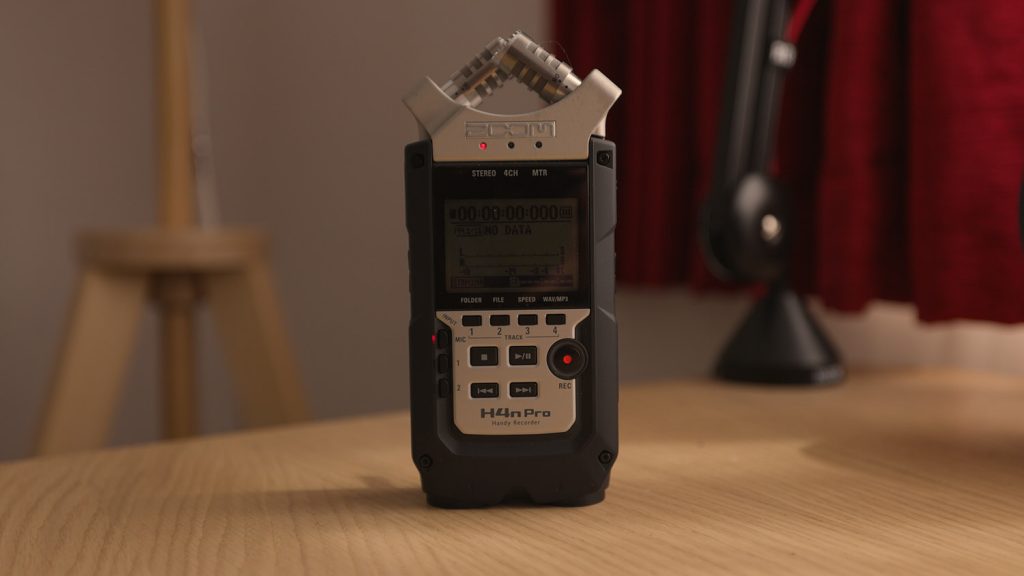
Recording Backup
One key difference between the two presented options, is the fact that the H6 has an integrated –12dB backup option.
When recording using this feature, the device captures an alternative, quieter recording. This way, if your recording peaks too high, and gets distorted, you can grab clips from the backup recording, and replace the unusable sections of the main recording.
Unfortunately though, the H4N Pro does not have this option.
Also, if you intend to utilise your Zoom recorder outdoors, it will be necessary to pick up some kind of windshield, in order to mitigate the effects of wind on your microphone.
My personal recommendation for this purpose is this Rycote kit, which offers a three in one solution.
A windshield, which protects the microphone from wind, a shock mount, which helps eliminate handling noise, and a grip, by which you can hold it. I have links down below for everything, including Rycote kits designed for both the H4n Pro, and the H6.
Interchangeability
Another aspect in which the Zoom H6 model is superior to its H4N Pro counterpart, is its versatility through the use of modular attachments.
Much like lenses on a DSLR camera, these capsules can be easily swapped, so that the capability of the device can be maximised in different situations.
As standard, the H6 model includes with it an X/Y capsule which utilises two separate unidirectional microphones, which are able to record audio across a wide area, whilst maintaining the strongest audio in the centre of the stereo image.
Furthermore, there are a plethora of separately sold modular attachments compatible with the Zoom H6 which are not compatible with its H4N Pro counterpart.
I’ve already mentioned in this video the EXH-6 Combo Input capsule, as well as the included XYH-6 capsule. However, the modular capacity of the Zoom H6 All Black does not stop there. Indeed, the mention of these two capsules hardly scratches the surface.
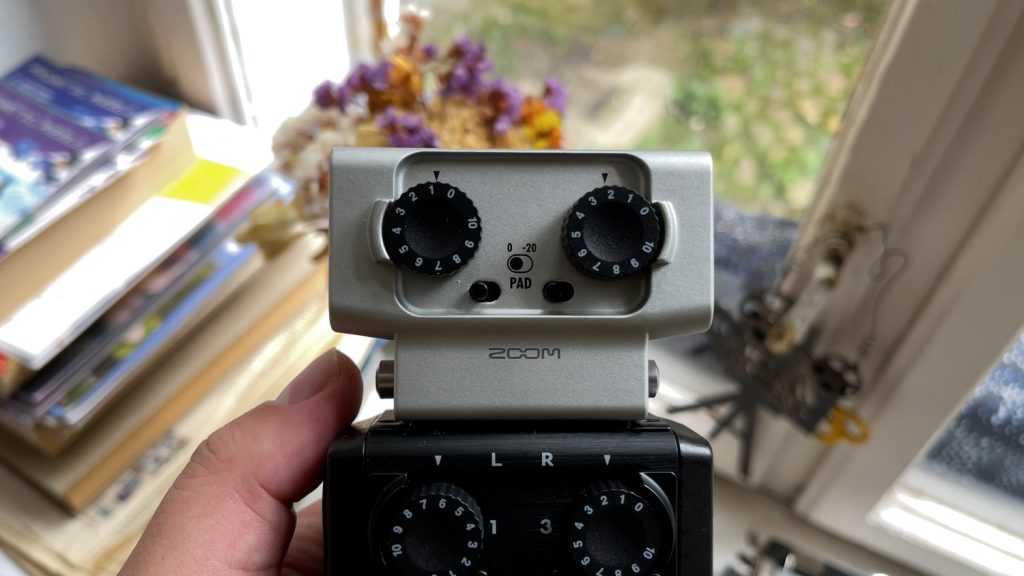
The MSH-6 capsule is another modular add-on compatible with the Zoom H6, and was included upon purchase of the previous, original Zoom H6 Grey recorder. This capsule enables you to manipulate the width of the stereo image after the recording has already taken place.
The SGH-6 Shotgun Microphone capsule allows you to record high quality sound using an affordable, compact, and highly directional shotgun microphone attachment, providing an alternative to the traditional expensive and large shotgun microphones.
As mentioned before, the voice over for this video is recorded using a Zoom H6, and this mic.
The XYH-5 Shock Mount capsule is similar to the previously mentioned XYH-6 capsule, except that this capsule, which is included with the Zoom H5, has in-built shock mounts. The role of this shock-mount is to reduce the unwanted noise caused by vibrations directly impacting the device itself.
The SSH-6 Mid-Side Stereo Shotgun capsule essentially combines the elements of two aforementioned modular capsules; the MSH-6 capsule and the SGH-6 Shotgun Microphone capsule.
With this modular attachment, you are able to utilise an incredibly directional shotgun microphone while also recording background sounds using a bidirectional side microphone.
This background audio can be manipulated in post-production, in order to include as much, or as little, environmental noise as you wish alongside the dialogue recorded with the shotgun mic.
Display
When it comes to the display, there are a few minor differences.
The H4N Pro model possesses an in-built backlit LCD display spanning 1.9 inches. While this screen is legible in low light, there can be a few visibility issues if utilising it on sunny days.
The H6 model, on the other hand, boasts a 2 inch tilted full-colour LCD display with adjustable brightness, a feature that is lacking in the H4N Pro alternative.
The screen tilt is useful if you want to mount the device on a DSLR for example, but it can make it difficult to see your levels if you’re using it like I am, to record voice overs.
Since I’m using a mic capsule, the screen is facing away from me, at an angle, thus making it impossible to see what’s happening.
Storage
When it comes to storage, the Zoom H6 allows for the utilisation of 128GB SD cards in order to store your audio files, whereas the Zoom H4N Pro only has the capacity to use 32GB SD cards.
I don’t know how much of an advantage this is really, as even when recording at 96 kHz, you’ll still be able to get hours and hours or audio, before filling up that 32 GB card.
Conclusion
So, in conclusion, which one should you buy?
Overall, both the Zoom H4N Pro and the Zoom H6 are relatively affordable, and offer some similar features.
The main aspect to consider is the number of external microphones you are likely to require, and if you will have any need for capsules.
If you need more than two inputs, the H6 is the better choice for you, due to its four built-in XLR inputs.
Alternatively, if you think that two external microphone inputs are sufficient, and you don’t need the capsules, then I would go ahead and save yourself some money by choosing the H4N Pro instead.
If you’re still not sure, I’d just go for the H6. It’s not that much more expensive, and you’re future proofing yourself, in case you do need to expand, and purchase more microphones.
Additionally, Zoom handheld devices, if kept in good condition, have historically preserved their value rather well. So, if you find that the H6 has too many features that you don’t need, you can always sell it, potentially recoup a good chunk of your money, and then purchase the H4n Pro.
If you’d like to have a look at any of the products mentioned in this article, or you would like to know how much they cost in your country, you can find affiliate links down below.
Thank you for reading my review of the Zoom H6 Black vs Zoom H4n Pro. I invite you to have a look at some of my other articles. We have something for everyone, whether you’re interested in audio, or cameras and lenses. Alternatively, if you prefer video reviews, feel free to have a look at my YouTube channel.
Product Links
Down below you will find all of the items I talked about in this article.
